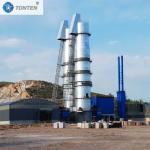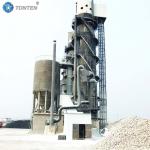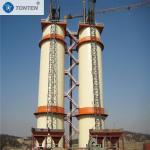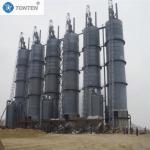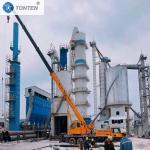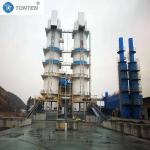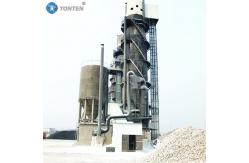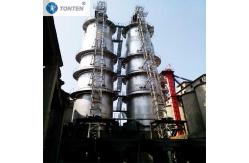Vertical Kiln Vertical Rotary Kiln Vertical Lime Kiln Calcining
Rotary Kiln
Vertical Kiln Product Introduction
After the qualified raw materials and solid fuel are evenly mixed
according to the proportion, they are sent to the shaft kiln for
calcining by the single bucket elevator. After calcining, the
finished products are discharged from the bottom of the shaft kiln
through the discharge device to the conveyor, and the conveyor will
send the finished products to the finished product bin. The hot
flue gas produced by calcination is purified by the dust removal
system and then discharged into the atmosphere.
1. The mechanized lime kiln is a kind of kiln, which can increase
the output by 30% compared with the earth kiln and can be
continuously calcined. The lime kiln is distributed by the upper
part. The central calcination section, the lower rotary discharge
section and the transmission part are composed of steel shell
structure.
2. Double-layer masonry of high aluminum refractory brick and clay
refractory brick is used in the kiln, and lightweight
heat-resistant concrete is cast between the masonry and the steel
shell. In particular, aluminum silicate heat-resistant fiber felt
is lined between the high-temperature calcination belt, kiln lining
and lightweight heat-resistant concrete injection layer, which
further improves the heat preservation effect and reduces the coal
blending ratio, thus saving energy.
3. The key is the use of rotary large tooth block unloading tower,
high-pressure centrifugal fan at the bottom of the ventilation
forced ventilation, with many tuyres on the unloading tower uniform
ventilation, uniform calcination, increase the activity of finished
lime, transmission adopts shaft support structure, gear drive,
fully able to withstand the kiln height of 17-27 meters within the
weight of the material, smooth transmission,
4. It is a mechanized furnace equipment that is currently being
promoted and used, which can be used for calcination of ordinary
building lime, calcination of activated lime with deslagging in
iron and steel plants, and calcination of raw materials of calcium
hydroxide, calcium carbonate and nano-calcium in chemical industry.
Vertical Kiln Structure
1. Kiln body: the main part of the shaft kiln, which is provided
with refractory lining and multi-layer grate.
2. Feeding and discharging device: located at the top and bottom of
the kiln, respectively responsible for adding raw materials to the
kiln and discharging clinker from the bottom of the kiln.
3. Ventilation equipment: to ensure the supply of air required for
combustion in the kiln and the discharge of combustion products.
Vertical Kiln Parameters Table
| Major equipment/capacity | 50 | 100 | 150 | 200 | 300 | 400 |
| Main supporting equipment models and technical and economic
indicators |
| Stock distributing device | BL-1 | BL-2 | BL-2 | BL-3 | BL-3 | BL-4V |
| Shaft kiln | 60m | 150m3 | 200㎡3 | 250m | 400㎡ | 500㎡ |
| Section form of kiln chamber | roundness |
| disembark | WF-1 | WF-2 | WF-2 | WF-3 | WF-4 | WF-5 |
| Calcination temperature | 1100±50 |
| Energy consumption index | 950±50 |
| Power consumption index | 25±5 |
| Limestone: lime | 1.6-1.75:1 |
| Lime burning rate /(%) | ≤13 |
| Lime activity /(ml) | 220-280(Depending on the composition of the limestone) |
| Ash discharge temperature (℃) | Ambient temperature +60 |
| Limestone into the kiln granularity | 30-80/80-120 |
| Emission concentration (mg/Nm') | ≤30 |
| Number of working days per year/day | ≥340 |
| Overhaul cycle/year7U | 3-5 |
| Number of operators (person/shift) | 2 |
| Suitable fuel | Massive anthracite, massive coke, massive petroleum coke, massive
biomass fuel, etc |
